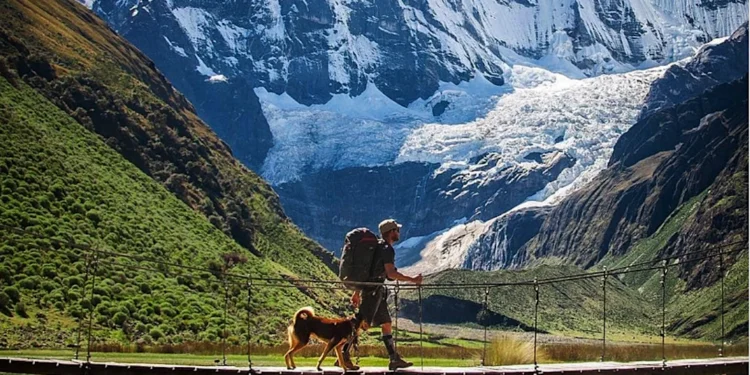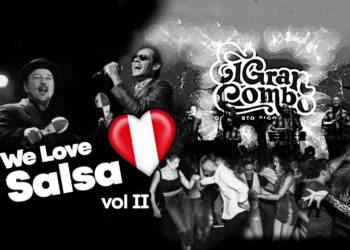This post is also available in:
Español
English
Stel je een pad voor dat tussen torenhoge bergen slingert, dorre woestijnen doorkruist en door weelderige jungles loopt. Een pad dat beschavingen met elkaar verbindt, heilige boodschappen overdraagt en de hartslag van een imperium zo groot als de Andes zelf in stand houdt. Dat is de Qhapaq Ñan, een van de meest bijzondere en minst bekende wonderen van de antieke wereld. Dit majestueuze wegennetwerk van de Inca’s, in 2014 door UNESCO uitgeroepen tot werelderfgoed, verbond niet alleen een imperium, maar blijft getuige van de grootsheid van een beschaving die zijn sporen heeft nagelaten in het hart van Zuid-Amerika.
Qhapaq Ñan: een kolossaal werk van de Andes
De Qhapaq Ñan, of ‘hoofdweg’ in Quechua, besloeg een indrukwekkend gebied van 4 miljoen vierkante kilometer. Het was de centrale as van het Inca-rijk en verenigde de gebieden die tegenwoordig Peru, Bolivia, Ecuador, Colombia, Argentinië en Chili vormen. Via dit uitgestrekte wegennet handhaafde het rijk de militaire controle, het politieke bestuur en de handel in een van de meest uitdagende regio’s ter wereld.
Een van de meest verbazingwekkende aspecten van de Qhapaq Ñan is zijn vermogen om zich aan te passen aan de meest gevarieerde landschappen: van de ijzige hoogten van de Andes tot de warme laaglanden van de Amazone. De Inca’s, zonder wielen of zware lastdieren, gebruikten dit systeem om zich te verplaatsen en essentiële producten zoals voedsel en textiel te vervoeren.
Het pad dat een imperium definieerde
De Qhapaq Ñan was essentieel voor de uitbreiding en het bestuur van de Tahuantinsuyo (naam van het Inca-rijk), waardoor de Sapa Inca’s (keizers) effectieve controle konden hebben over hun uitgestrekte grondgebied. De Inca’s legden niet alleen een weg aan, maar richtten ook tampus op, dit waren herbergen of rustplaatsen langs de route, waar reizigers zich konden bevoorraden en uitrusten. Deze tambo’s sloegen ook voorraden op voor de chasquis, Inca-boodschappers die te voet lange afstanden aflegden en belangrijk nieuws brachten.
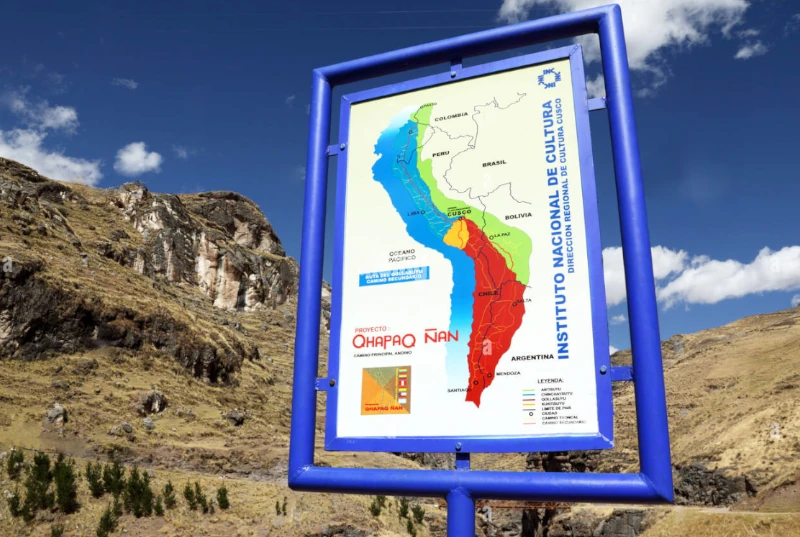
Zonder Qhapaq Ñan zou Pizarro nooit daarin geslaagd zijn
Een van de meest opvallende aspecten van het verhaal is dat zonder de Qhapaq Ñan de Spaanse invasie onder leiding van Francisco Pizarro zou zijn mislukt. De veroveraars, die grotendeels analfabeet maar onverschrokken waren, kenden de geografie van het gebied niet. Zonder de wegeninfrastructuur van Qhapaq Ñan zouden Pizarro en zijn volk verdwaald zijn geweest in de uitgestrektheid en ruige landschappen van de Andes, waardoor hun avontuur in gewelddadige vergetelheid zou zijn geëindigd.
Dankzij de Qhapaq Ñan konden de Spanjaarden snel door het rijk trekken, toegang krijgen tot de steden, ze plunderen en de machtscentra innemen. Het was toen dankzij Qhapaq Ñan dat ze de controle konden overnemen over een imperium dat anders ontoegankelijk zou zijn geweest. Dit netwerk verbond niet alleen het rijk fysiek, maar vertegenwoordigde ook een bron van macht en logistieke efficiëntie waarvan Pizarro wist hoe hij hiervan kon profiteren.
De Grote Incaroute: een hedendaags getuigenis
De Qhapaq Ñan blijft fascinatie opwekken. De auteur en avonturier Ricardo Espinosa Reyes, bekend als “El Caminante”, reisde door dit enorme netwerk van wegen om het te documenteren in zijn werk “The Great Inca Route – El Qhapaq Ñan” (2004). In dit boek beschrijft hij in detail de majesteit van het wegennet en de verbindingen ervan met de natuurlijke omgeving, en onthult hoe de Inca’s erin slaagden zulke uitgestrekte gebieden te verenigen door middel van geavanceerde techniek. Espinosa Reyes bewandelde niet alleen de historische paden, maar vereeuwigde de erfenis van de Inca’s en nodigde moderne lezers uit om de grootsheid van dit padensysteem te herontdekken.
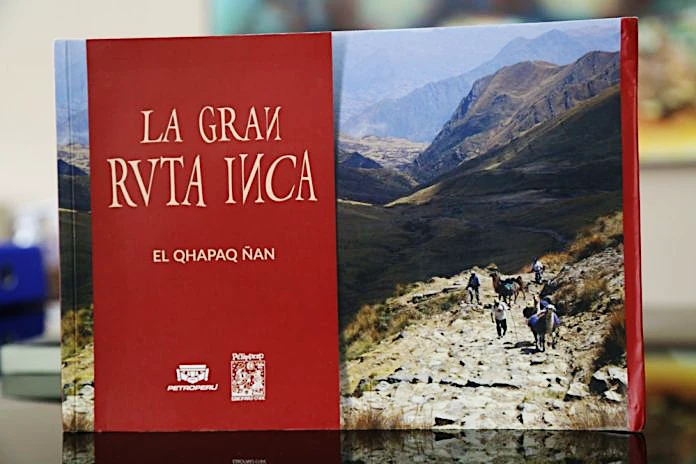
Qhapaq Ñan vandaag: een reis die de tijd overstijgt
Tegenwoordig is het toeren door de Qhapaq Ñan een ervaring die verder gaat dan alleen toerisme. Het is een spirituele reis, een onderdompeling in de geschiedenis en een verbinding met de levende culturen van de Andes. Bezoekers kunnen verschillende delen van deze oude route verkennen, waarvan de bekendste de Inca Trail is die naar de legendarische stad Machu Picchu leidt.
Voor reizigers die verder willen gaan dan de traditionele routes, zijn er paden die door minder bekende maar even indrukwekkende landschappen lopen. De Qhapaq Ñan-routes die aansluiten op Choquequirao worden bijvoorbeeld steeds populairder onder liefhebbers van avontuur en trekking. Deze routes laten je niet alleen spectaculaire landschappen verkennen, maar bieden ook de mogelijkheid om in contact te komen met Andes-gemeenschappen die hun voorouderlijke tradities nog steeds levend houden.

Cómo Recorrer el Qhapaq Ñan: Guía para Viajeros
Tegenwoordig blijft Qhapaq Ñan een magneet voor toeristen en avonturiers die meer willen weten over de geschiedenis en natuurlijke schoonheid van de Andes. Hoe de Qhapaq Ñan bezichtigen?: Gids voor reizigers
Bereikbaarheid: Er zijn verschillende Qhapaq Ñan-routes die door toeristen kunnen worden verkend, van korte routes tot expedities die meerdere dagen duren. De bekendste is de Inca Trail-route naar Machu Picchu, waarvoor vanwege de populariteit maanden van tevoren gereserveerd moet worden. Andere routes, zoals die naar Vilcabamba of Choquequirao, zijn uitdagender, maar minder druk.
Aanbevelingen:
- Fysieke conditie: Sommige delen van de Qhapaq Ñan vereisen een goede fysieke conditie vanwege de hoogte en het moeilijke terrein.
- Gids: Het is raadzaam om ervaren gidsen in te huren, vooral op minder bereisde routes.
- Uitrusting: Het is essentieel om warme kleding, geschikte wandelschoenen, zonnebrandcrème en voldoende water mee te nemen.
Hoogte: Veel van de Qhapaq Ñan-routes bevinden zich meer dan 3000 meter boven zeeniveau, dus het is essentieel om te acclimatiseren voordat u aan de reis begint.
Sommige delen van de Qhapaq Ñan werden als heilige routes beschouwd en waren gewijd aan religieuze rituelen, dus hun doorvoer was beperkt tot speciale evenementen.
Waarom Qhapaq Ñan bezoeken?
De Qhapaq Ñan is niet alleen een fysiek pad, het is een route die de reiziger door de tijd vervoert en hem verbindt met de spiritualiteit, techniek en majesteit van een van de meest geavanceerde beschavingen in de geschiedenis. De impact van dit wegennet leeft vandaag de dag voort, niet alleen in de Andesgemeenschappen die er nog steeds gebruik van maken, maar ook in het historische verhaal van Zuid-Amerika.
Een bezoek aan Qhapaq Ñan is een unieke ervaring die verder gaat dan toerisme: het is een onderdompeling in cultuur, natuur en geschiedenis. Voor avonturiers en geschiedenisliefhebbers is dit een reis die je niet mag missen.
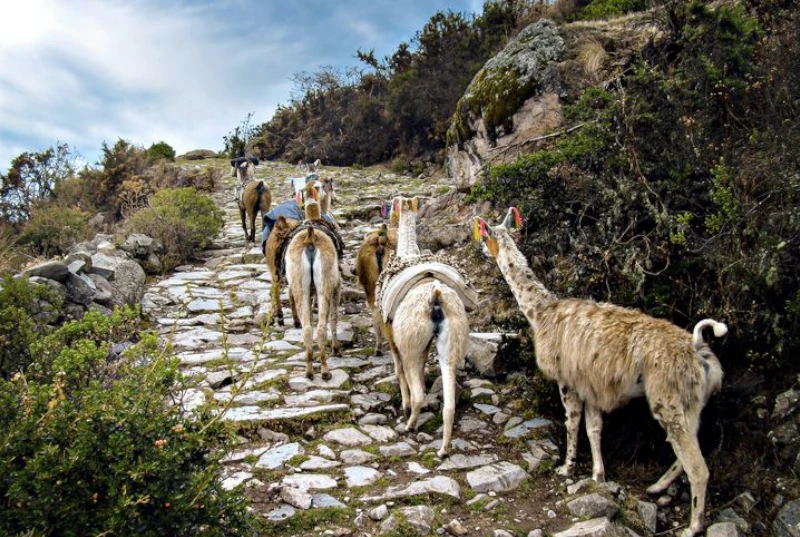
Nieuwsgierige feiten over de Qhapaq Ñan
Geografische diversiteit: De Qhapaq Ñan doorkruist een van de meest diverse geografische gebieden ter wereld, van hoge bergen en plateaus tot tropische bossen en kustwoestijnen.
Bouwtechnologie: De Inca’s ontwikkelden geavanceerde technische technieken voor het aanleggen van wegen die bestand waren tegen de extreme weersomstandigheden van de Andes. Ze gebruikten lokale materialen en plaveiden de paden in veel gevallen met stenen.
Spirituele route: Sommige delen van de Qhapaq Ñan werden als heilige routes beschouwd en waren gewijd aan religieuze rituelen, dus hun doorvoer was beperkt tot speciale evenementen.
Internationale verbindingen: Hoewel de weg zijn oorsprong vond in het Inca-rijk, was het netwerk verbonden met andere wegen en handelsroutes in wat nu Argentinië, Chili en Ecuador is, waardoor culturen en economieën van vóór de Inca werden geïntegreerd.
De Qhapaq Ñan blijft een levend getuigenis van de techniek, cultuur en spiritualiteit van de Inca’s. Wanneer je de eeuwenoude paden bewandelt, is het onmogelijk om het gewicht van de geschiedenis, de grootsheid van de natuur en de verbinding met een rijk dat de Andes domineerde niet te voelen. Dit is meer dan een pad: het is een route naar het verleden en een kans om opnieuw verbinding te maken met de geschiedenis van Zuid-Amerika.
Durven
Durf jij een rondleiding door de Qhapaq Ñan aan?
Laat ons uw opmerkingen achter over welk deel van dit geweldige netwerk van wegen u zou willen verkennen, deel dit artikel met uw vrienden en abonneer u op onze website om meer inhoud te ontvangen over toeristische bestemmingen, grote wonderen en onze Peruaanse cultuur. Je volgende avontuur begint hier.


